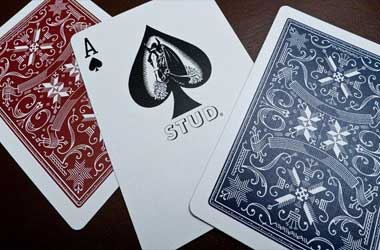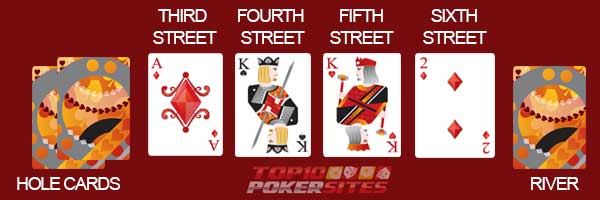Stud Poker – How to Play? Rules, Tips and Strategies

Many historians believe that the first poker game played in the States was remarkably similar to the Persian game As-Nas as it was played with a deck of 20 cards, with five cards dealt to each player.
The poker we know and love today came later, in the mid-18th century, with a 52-card deck and multiple variants, most notably straight poker and stud. Poker soon spread through the country thanks to Mississippi riverboats, where gambling was a common occurrence.
The American Civil War brought about additional variants of poker, including five-card stud poker. This marks the earliest known appearance of stud poker in the United States. Additionally, it is believed seven-card stud poker developed sometime in the 20th century and became more common in both casino and home-based poker games.
What Is Stud Poker?
If you’ve only played straight poker until now but you want to expand your horizons, stud poker is a great starting point. Stud poker can encompass several poker variants in which a player is dealt a number of face-down and face-up cards in multiple betting rounds.
To be more specific, the player receives the first card face-down and the other four cards face-up in the first version of stud poker. Each betting round occurs after a card has been dealt to each player. This means that the number of betting rounds is the same as the number of cards in each player’s hands.
Stud games are considered non-positional games, meaning the player that bets first in the first round might not be the first to bet in the second one. Furthermore, stud poker features an unofficial rule that the player starting the round should be the one whose face-up cards make the best hand in the game.
Basic Stud Poker Play
As you might know, poker has different betting structures, which influence the number of betting rounds in a game and how it is played. Generally, it is understood that games with four or fewer betting rounds (like five-card stud) work well with any betting structure and are well suited for pot-limit and no-limit plays. On the other hand, games with more betting rounds are best suited for spread-limit or fixed-limit plays.
It is recommended for later betting rounds to feature higher limits compared to earlier ones. Take, for example, the $5/$10 seven-card stud game featured in some Nevada casinos, where you start the betting with $5 bets in the first two rounds and continue it with $10 bets later. There are also $5/$10/$20 seven-card stud games where you get to bet $20 only in the last round.
Another typical play is to allow larger bets to be made in the second round if there is an open pair. That means that at least one player’s face-up cards make a pair.
Another interesting fact is that stud poker implements names for each round of play. Each betting round is called after the number of cards players have in their hands when the round begins. So the round is called fourth card or fourth street if the players are holding four cards, for example. However, the final round is commonly called the river or the end regardless of the number of betting rounds.
Stud Poker Variants
As I’ve already mentioned, there are numerous stud poker variants that might intrigue you. Take a look at some of the most commonly played stud poker variants below and learn how to play them.
Five-Card Stud
Although five-card stud is not as popular as it was a few centuries ago, it is still the first choice in some European countries, like Finland. Bear in mind that land-based and online five-card stud variants differ when it comes to betting rounds.The former allows for betting after the cards have been dealt, while the latter requires players to ante up their bets in advance. When it comes to the game’s rules, just follow the rules I’ve outlined before, and you’ll be good to go.
Seven-Card Stud
Seven-card stud is the most widespread stud poker game in the United States. It differs from its predecessor as each player first receives one face-up and one face-down card. The player with the lowest-ranking cards opens the betting round, and betting proceeds in a clockwise order after that.Another card is then dealt, followed by another betting round. The game continues this way until the fifth betting round, when another down card is dealt, which might call for a showdown. This is why seven-card stud poker is also known as two down, four up, one down, or 2-4-1.
On top of the original variant of the seven-card stud, there are about ten more variants. You might not be able to find all of these versions in casinos, but they’re great fun for home poker nights.
Six-Card Stud
Six-card stud poker follows the same rules as seven-card stud with a slight difference — the last face-up round is removed. That means the game is two down, three up, one down. It can also be played similarly to five-card stud but with the first betting round taking place after two cards are dealt.Razz
This stud variant allows the player with the lowest hand to win the pot instead of the highest. The rules differ depending on the razz version you’re playing, as you’re not treating straight and flushes the same way. If you want to count the straights against someone, you should opt for the London Lowball version.High-Low Stud
As the name suggests, high-low stud poker is played using high-low split betting. That means the pot is split between the player with the lowest hand and the player with the highest. The most common form is the stud-eight or eight or better poker, which means that an 8-high hand or lower is required to win low. If there’s no low hand, the high hand wins the entire pot. A less common variant is Q, played without a qualifier for the low half of the pot.Caribbean Stud
Caribbean Stud is a combination of the traditional five-card stud and the classic poker game. More specifically, the game was developed using the general rules of five-card stud and poker hands. What sets this game apart is that each player plays against the dealer.Other Stud Poker Variants
The number of stud poker variants is quite high, so it would be impossible to go through them without giving you a couple of hours’ worth of reading material. For that reason, take a look at all of them and if one catches your eye, leave a comment below to let me know.- Mexican Stud
- Option Alley
- Scandinavian Stud
- Seven-Card Flip
- Kentrel
- Show Hand
- Chicago
- Little Chicago
- Big Chicago
- The Bitch
- Baseball
- Cowpie Poker
- Number Nine
- Dr. Pepper
- Draft
- Auction
- Telesina
Hi, I am the Chief Editor of top10pokersites.net, this site is dedicated to all thing poker. I have been working around the poker industry for the last 15 years, with different brands. The main purpose of this site is to keep you uptodate with the industry and offer you the best deals around.











